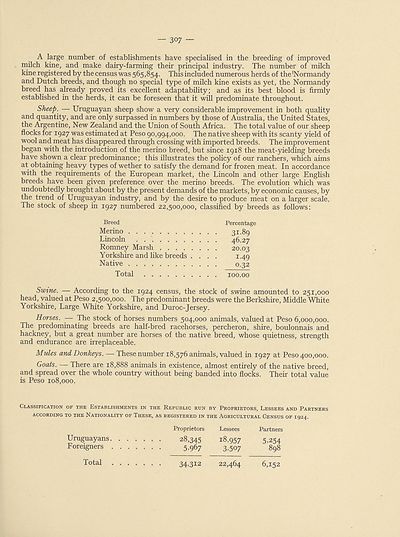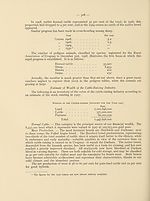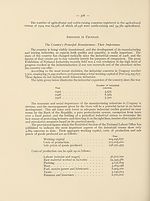Download files
Complete book:
Individual page:
Thumbnail gallery: Grid view | List view

307
A large number of establishments have specialised in the breeding of improved
milch kine, and make dairy-farming their principal industry. The number of milch
kine registered by the census was 565,854. This included numerous herds of the 'Normandy
and Dutch breeds, and though no special type of milch kine exists as yet, the Normandy
breed has already proved its excellent adaptability; and as its best blood is firmly
established in the herds, it can be foreseen that it will predominate throughout.
Sheep. — Uruguayan sheep show a very considerable improvement in both quality
and quantity, and are only surpassed in numbers by those of Australia, the United States,
the Argentine, New Zealand and the Union of South Africa. The total value of our sheep
flocks for 1927 was estimated at Peso 90,994,000. The native sheep with its scanty yield of
wool and meat has disappeared through crossing with imported breeds. The improvement
began with the introduction of the merino breed, but since 1918 the meat-yielding breeds
have shown a clear predominance; this illustrates the policy of our ranchers, which aims
at obtaining heavy types of wether to satisfy the demand for frozen meat. In accordance
with the requirements of the European market, the Lincoln and other large English
breeds have been given preference over the merino breeds. The evolution which was
undoubtedly brought about by the present demands of the markets, by economic causes, by
the trend of Uruguayan industry, and by the desire to produce meat on a larger scale,
The stock of sheep in 1927 numbered 22,500,000, classified by breeds as follows:
Breed Percentage
Merino 31-89
Lincoln . 46.27
Romney Marsh 20.03
Yorkshire and like breeds .... 1.49
Native 0.32
Total 100.00
Swine. — According to the 1924 census, the stock of swine amounted to 251,000
head, valued at Peso 2,500,000. The predominant breeds were the Berkshire, Middle White
Yorkshire, Large White Yorkshire, and Duroc-Jersey.
Horses. — The stock of horses numbers 504,000 animals, valued at Peso 6,000,000.
The predominating breeds are half-bred racehorses, percheron, shire, boulonnais and
hackney, but a great number are horses of the native breed, whose quietness, strength
and endurance are irreplaceable.
Mules and Donkeys. — These number 18,576 animals, valued in 1927 at Peso 400,000.
Goats. — There are 18,888 animals in existence, almost entirely of the native breed,
and spread over the whole country without being banded into flocks. Their total value
is Peso 108,000.
Classification of the Establishments in the Republic run by Proprietors, Lessees and Partners
ACCORDING TO THE NATIONALITY OF THESE, AS REGISTERED IN THE AGRICULTURAL CENSUS OF I924.
Proprietors Lessees Partners
Uruguayans . 28,345 18,957 5,254
Foreigners 5,967 3,507 898
Total 34.312 22,464 6,152
A large number of establishments have specialised in the breeding of improved
milch kine, and make dairy-farming their principal industry. The number of milch
kine registered by the census was 565,854. This included numerous herds of the 'Normandy
and Dutch breeds, and though no special type of milch kine exists as yet, the Normandy
breed has already proved its excellent adaptability; and as its best blood is firmly
established in the herds, it can be foreseen that it will predominate throughout.
Sheep. — Uruguayan sheep show a very considerable improvement in both quality
and quantity, and are only surpassed in numbers by those of Australia, the United States,
the Argentine, New Zealand and the Union of South Africa. The total value of our sheep
flocks for 1927 was estimated at Peso 90,994,000. The native sheep with its scanty yield of
wool and meat has disappeared through crossing with imported breeds. The improvement
began with the introduction of the merino breed, but since 1918 the meat-yielding breeds
have shown a clear predominance; this illustrates the policy of our ranchers, which aims
at obtaining heavy types of wether to satisfy the demand for frozen meat. In accordance
with the requirements of the European market, the Lincoln and other large English
breeds have been given preference over the merino breeds. The evolution which was
undoubtedly brought about by the present demands of the markets, by economic causes, by
the trend of Uruguayan industry, and by the desire to produce meat on a larger scale,
The stock of sheep in 1927 numbered 22,500,000, classified by breeds as follows:
Breed Percentage
Merino 31-89
Lincoln . 46.27
Romney Marsh 20.03
Yorkshire and like breeds .... 1.49
Native 0.32
Total 100.00
Swine. — According to the 1924 census, the stock of swine amounted to 251,000
head, valued at Peso 2,500,000. The predominant breeds were the Berkshire, Middle White
Yorkshire, Large White Yorkshire, and Duroc-Jersey.
Horses. — The stock of horses numbers 504,000 animals, valued at Peso 6,000,000.
The predominating breeds are half-bred racehorses, percheron, shire, boulonnais and
hackney, but a great number are horses of the native breed, whose quietness, strength
and endurance are irreplaceable.
Mules and Donkeys. — These number 18,576 animals, valued in 1927 at Peso 400,000.
Goats. — There are 18,888 animals in existence, almost entirely of the native breed,
and spread over the whole country without being banded into flocks. Their total value
is Peso 108,000.
Classification of the Establishments in the Republic run by Proprietors, Lessees and Partners
ACCORDING TO THE NATIONALITY OF THESE, AS REGISTERED IN THE AGRICULTURAL CENSUS OF I924.
Proprietors Lessees Partners
Uruguayans . 28,345 18,957 5,254
Foreigners 5,967 3,507 898
Total 34.312 22,464 6,152
Set display mode to:
![]() Universal Viewer |
Universal Viewer | ![]() Mirador |
Large image | Transcription
Mirador |
Large image | Transcription
Images and transcriptions on this page, including medium image downloads, may be used under the Creative Commons Attribution 4.0 International Licence unless otherwise stated. ![]()
| League of Nations > Economic and financial section > Agricultural crisis > Volume 1 > (311) |
|---|
| Permanent URL | https://digital.nls.uk/190906693 |
|---|
| Shelfmark | LN.II.2/2.(35) |
|---|---|
| Attribution and copyright: |
|
| Shelfmark | LN.II.2/2.(35-35) |
|---|---|
| Shelfmark | LN.II |
|---|
| Description | Over 1,200 documents from the non-political organs of the League of Nations that dealt with health, disarmament, economic and financial matters for the duration of the League (1919-1945). Also online are statistical bulletins, essential facts, and an overview of the League by the first Secretary General, Sir Eric Drummond. These items are part of the Official Publications collection at the National Library of Scotland. |
|---|---|
| Additional NLS resources: |
|

